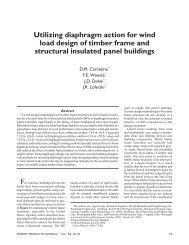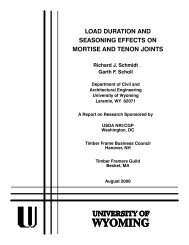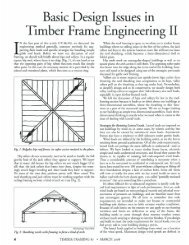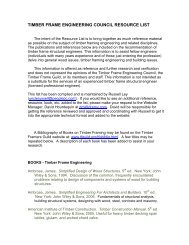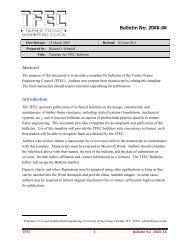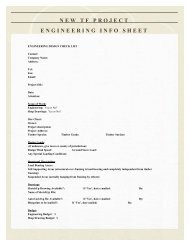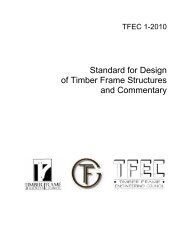Timber Frame Tension Joinery - Timber Frame Engineering Council
Timber Frame Tension Joinery - Timber Frame Engineering Council
Timber Frame Tension Joinery - Timber Frame Engineering Council
Create successful ePaper yourself
Turn your PDF publications into a flip-book with our unique Google optimized e-Paper software.
Studies in the U. S. that adapt and apply the European yield model to domestic<br />
practice for bolted connections are reported in (Thangjitham, 1981; McLain and<br />
Thangjitham, 1983; Soltis et al., 1986; Soltis et al., 1987; Soltis and Wilkinson, 1987;<br />
Wilkinson, 1993).<br />
Technical literature on timber frame joinery design is limited. Reviews of current<br />
practice, which is based on interpretations of past research and available design standards,<br />
are found in (Brungraber, 1992a; Brungraber, 1992b). Alternatives to all-wood joinery<br />
involving metallic fasteners are described in (Brungraber, 1992a) and (Duff et al., 1996).<br />
There are several craft-oriented books that present the history, architectural design,<br />
and construction techniques for timber frames. These include (Elliot and Wallas, 1977;<br />
Benson and Gruber, 1980; Sobon and Schroeder, 1984; Benson, 1997; Sobon 1994). In<br />
these books, details related to engineering design are usually limited to span tables for<br />
bending members (floor beams). Carpentry details of Oriental joinery are found in (Seike,<br />
1977).<br />
Even though the joinery used in timber-frame structures resembles that used by<br />
carpenters in the furniture industry, significant differences exist. The basic mortise and<br />
tenon joint used in furniture construction (Hill and Eckelman, 1973) includes a relatively<br />
short (stub) tenon and relies on adhesives to secure the joint. Doweled joints in furniture<br />
(Eckelman, 1970; 1979) use the wood dowel as a replacement for the tenon, rather than as<br />
an anchor to prevent tenon withdrawal from the mortise. These joints also rely on adhesives<br />
to secure the joint. Hence, the relatively large body of literature in furniture joinery is not<br />
applicable to the structural systems considered here.<br />
9




